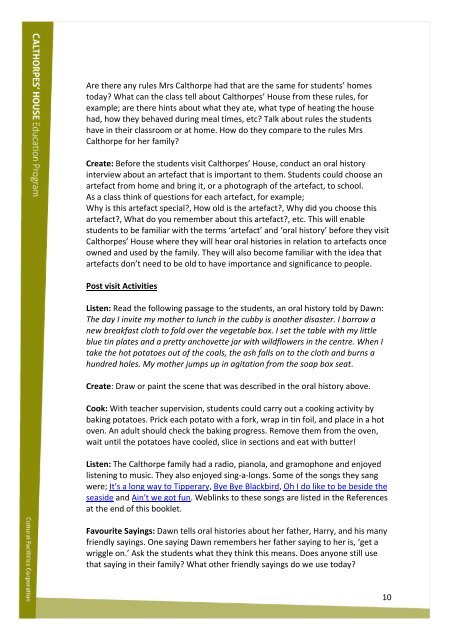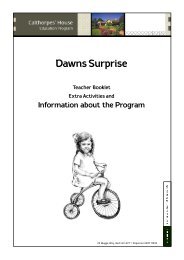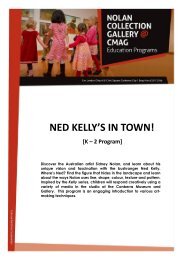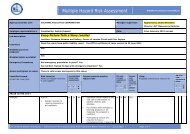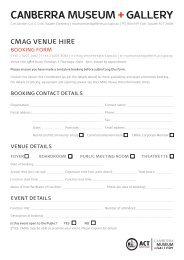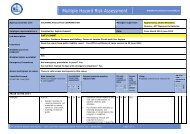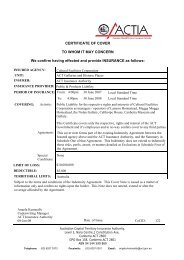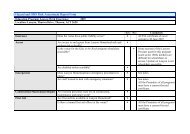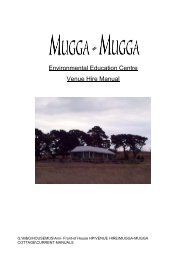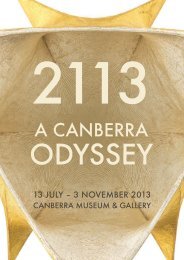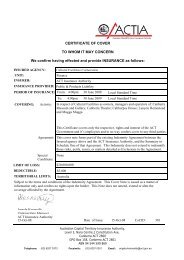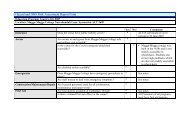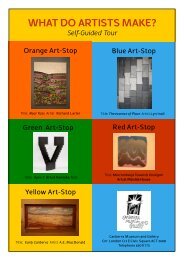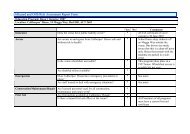Download Teachers Booklet - ACT Museums and Galleries
Download Teachers Booklet - ACT Museums and Galleries
Download Teachers Booklet - ACT Museums and Galleries
You also want an ePaper? Increase the reach of your titles
YUMPU automatically turns print PDFs into web optimized ePapers that Google loves.
Are there any rules Mrs Calthorpe had that are the same for students’ homes<br />
today What can the class tell about Calthorpes’ House from these rules, for<br />
example; are there hints about what they ate, what type of heating the house<br />
had, how they behaved during meal times, etc Talk about rules the students<br />
have in their classroom or at home. How do they compare to the rules Mrs<br />
Calthorpe for her family<br />
Create: Before the students visit Calthorpes’ House, conduct an oral history<br />
interview about an artefact that is important to them. Students could choose an<br />
artefact from home <strong>and</strong> bring it, or a photograph of the artefact, to school.<br />
As a class think of questions for each artefact, for example;<br />
Why is this artefact special, How old is the artefact, Why did you choose this<br />
artefact, What do you remember about this artefact, etc. This will enable<br />
students to be familiar with the terms ‘artefact’ <strong>and</strong> ‘oral history’ before they visit<br />
Calthorpes’ House where they will hear oral histories in relation to artefacts once<br />
owned <strong>and</strong> used by the family. They will also become familiar with the idea that<br />
artefacts don’t need to be old to have importance <strong>and</strong> significance to people.<br />
Post visit Activities<br />
Listen: Read the following passage to the students, an oral history told by Dawn:<br />
The day I invite my mother to lunch in the cubby is another disaster. I borrow a<br />
new breakfast cloth to fold over the vegetable box. I set the table with my little<br />
blue tin plates <strong>and</strong> a pretty anchovette jar with wildflowers in the centre. When I<br />
take the hot potatoes out of the coals, the ash falls on to the cloth <strong>and</strong> burns a<br />
hundred holes. My mother jumps up in agitation from the soap box seat.<br />
Create: Draw or paint the scene that was described in the oral history above.<br />
Cook: With teacher supervision, students could carry out a cooking activity by<br />
baking potatoes. Prick each potato with a fork, wrap in tin foil, <strong>and</strong> place in a hot<br />
oven. An adult should check the baking progress. Remove them from the oven,<br />
wait until the potatoes have cooled, slice in sections <strong>and</strong> eat with butter!<br />
Listen: The Calthorpe family had a radio, pianola, <strong>and</strong> gramophone <strong>and</strong> enjoyed<br />
listening to music. They also enjoyed sing‐a‐longs. Some of the songs they sang<br />
were; It's a long way to Tipperary, Bye Bye Blackbird, Oh I do like to be beside the<br />
seaside <strong>and</strong> Ain't we got fun. Weblinks to these songs are listed in the References<br />
at the end of this booklet.<br />
Favourite Sayings: Dawn tells oral histories about her father, Harry, <strong>and</strong> his many<br />
friendly sayings. One saying Dawn remembers her father saying to her is, ‘get a<br />
wriggle on.’ Ask the students what they think this means. Does anyone still use<br />
that saying in their family What other friendly sayings do we use today<br />
10


